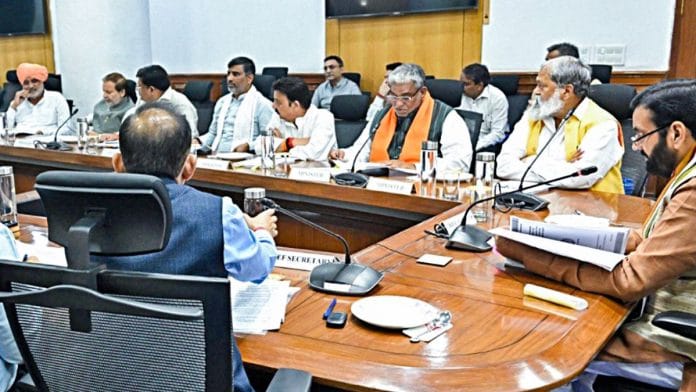Gurugram: Haryana’s ambitious anti-corruption drive, launched with much fanfare in January this year with a deputy commissioner being asked to act against some revenue officials found to be “corrupt” by the government’s internal process, has spectacularly boomeranged, entangling the state government in a legal quagmire.
The campaign, which saw the Revenue and Disaster Department circulate a “confidential” list identifying 370 patwaris (revenue officials) as “corrupt” alongside 170 middlemen, was meant to signal Chief Minister Nayab Singh Saini’s zero-tolerance policy on graft.
Instead, the leaked document has triggered a public interest litigation (PIL) in the Punjab and Haryana High Court, which has now demanded answers on the leak of the list, and the actions taken against those named.
The court’s scrutiny has exposed procedural lapses and raised questions on the violation of fundamental rights under Article 21 of the Constitution, turning the state’s anti-corruption crusade into a public relations and legal debacle.
Also read: Haryana govt cracks whip: 80 irrigation officials in soup over quality of concrete used in projects
The Genesis of the Controversy
On 14 January 2025, the Haryana government issued a confidential letter to deputy commissioners (DCs) across the state, directing them to take stringent action against 370 patwaris accused of corrupt practices, such as demanding bribes for land mutations, measurements, record corrections, and map approvals.
The list, compiled with inputs from the state intelligence wing, also named 170 private individuals acting as middlemen, facilitating bribes ranging from Rs 200 to Rs 10,000 per task. Kaithal topped the list with 46 “corrupt” patwaris, followed by Sonipat (41), Mahendragarh (36), Gurugram (27), and Fatehabad (25), while Panchkula reported none. The letter, marked “very important,” instructed DCs to submit action reports within 15 days, aiming to curb practices that tarnished the government’s image.
However, the document, intended as an internal directive, was leaked in to the public domain, sparking widespread media coverage.
The list’s details, including the caste of each patwari and their posting duration, added fuel to the fire, raising concerns about fairness and transparency.
High Court’s Intervention
The leak prompted Sahibjit Singh Sandhu to file a PIL through his advocate Ishani Goyal in the Punjab and Haryana High Court, alleging that the public disclosure of the list without formal departmental inquiries violated the fundamental rights of the 370 patwaris and 170 middlemen under Article 21, which guarantees the right to life and personal liberty.
Goyal argued on behalf of the petitioner that labelling individuals as “corrupt” without due process or verification constituted a gross injustice. She further contended that the Revenue Department failed to safeguard the confidentiality of the document, allowing its illegal disclosure to harm the reputation of those named.
During a hearing on 7 July 2025, the High Court took a stern view, terming the matter “serious” and ordering the Haryana government to submit details within a week on the actions taken against the officer responsible for the leak and the steps initiated against the listed individuals.
The state sought additional time to respond, leading the court to adjourn the hearing to 14 July 2025. The court’s directive underscored the government’s failure to protect the confidentiality of what it admitted was its “most confidential document” and questioned why the list was made public without a proper probe.
In its response, the Haryana government informed the court that a deputy superintendent-rank officer in the Revenue Department had been suspended for leaking the list, and the list was meant for internal circulation of the government and not meant to be made public.
Interestingly, in January of this year, Haryana Minister for Revenue and Disaster Management Vipul Goel had told ThePrint that the state government had ordered a survey of patwaris and subsequently prepared a list after receiving numerous complaints of corruption.
Goel had stated that the government’s action would send a positive message to both the public and honest officials, while serving as a lesson for the corrupt. He had explained that the government was resolved to eliminate corruption at all levels, not just among patwaris, and was committed to ensuring transparency. He had also added that strict action, including suspension, termination, and legal proceedings, would be taken against those found guilty.
The PIL also demanded that the list be withdrawn from the public domain, that further publication or dissemination be halted, and that an independent inquiry identify and hold accountable those responsible for the leak.
Patwaris are critical cogs in Haryana’s revenue machinery, responsible for maintaining land records, certifying possession, processing mutations, and correcting errors in property documents. Their direct interface with the public makes their role prone to corruption, as citizens often face delays or objections unless bribes are paid.
The leaked list detailed specific malpractices: In Gurugram, patwaris allegedly charged Rs 3,000–5,000 for land mutations and maps; in Charkhi Dadri, Rs 1,000–2,000; and in Faridabad, Rs 500–700 just to locate old revenue files. Some patwaris employed middlemen to collect bribes, while others, like one in Tosham, directly demanded payments for processing mutations. In Mahendragarh, a patwari doubled as a property dealer, delegating official tasks to a middleman, while in Hisar, another rarely attended work, forcing citizens to bribe intermediaries.
The PIL’s contention that the list’s publication violated Article 21 has resonated, as it raises questions about the reputational damage inflicted on patwaris and middlemen without evidence from formal inquiries. The government’s claim that the PIL is invalid because the petitioner, Sahibjit Singh Sandhu, is neither a patwari nor directly affected has so far failed to sway the court, which views the matter as a broader issue of public interest.
(Edited by Viny Mishra)






